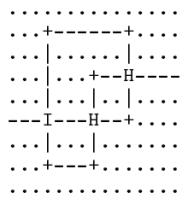|
G |
World
of Knots Input: Standard Input Output: Standard Output |
|
Today, we will be unraveling the mysteries
of one of the most twisted and curly beasts in all existence – knots! The
problem here is simple: given the picture of a string laid out curled on a
table, you are to determine if it will curl up into a knot when the ends are
pulled out.

The input will consist of a diagram of
one single continuous string described in a two dimensional grid of characters
such as shown above. The '-' and '|' characters
represent a horizontal and vertical segment of the string, respectively. '+' characters represent corners where the string turns at
right angles on the table. 'I' or 'H' characters represent locations where parts of the strings
cross:
•
'H' represents locations where the
horizontal string passes over the vertical string
•
'I' represents locations where the
horizontal string passes under the vertical string
The dot character, '.', obviously, represents empty spaces of the table unoccupied
by the string. Two horizontally adjacent nonempty spaces of the table are
connected by the string iff neither of them are '|'
characters. Similarly, vertically adjacent nonempty spaces are connected by the
string iff neither of them are '-' characters. Inputs will be such that every '+' character will represent a proper corner where the string
turns at a unambiguously at a right angle: formally, every '+' character will be connected to exactly one vertically
adjacent and exactly one horizontally adjacent space.
Moreover, to further simplify matters,
you can assume that the only characters along the border of the given diagram,
other than dots, will represent endpoints of the string. In short, the input
will unambiguously specify a valid piece of string starting and ending at the
border of the input diagram. Finally, assume that the string has negligible width and is made of a
very smooth material, so that parts of the string can easily slide over each
other with negligible friction.
Input
The input will consist of at most 80 test
cases. Each test case will start with a single line containing two integers, r
and c, indicating that the size of the diagram for that case is of r
rows and c columns. This line will be followed by r more
lines, each with exactly c characters, with characters in each line
representing a row of the diagram. You may assume that 2 ≤ r,c ≤
120. Input is terminated by a line containing two zeroes. This line should not
be processed.
Output
The output should consist of exactly one
line for each test case in the format
“Case c: Response”,
where c is the test case serial
number, starting from 1, and Response is either the string “straightened” or “knotted” (without the quotes) depending
on whether the string will straighten out or coil up into a knot, respectively.
See the sample for further
clarifications.
Sample Input Output for
Sample Input
|
9 15 ............... ...+------+.... ...|......|.... ...|...+--H---- ...|...|..|.... ---I---H--+.... ...|...|....... ...+---+....... ............... 9 15 ............... ...+------+.... ...|......|.... ...|...+--I---- ...|...|..|.... ---I---H--+.... ...|...|....... ...+---+....... ............... 0
0 |
Case 1: knotted Case 2: straightened |
Problemsetter: Samee Zahur
Special
Thanks: Manzurur Rahman Khan
